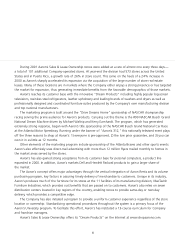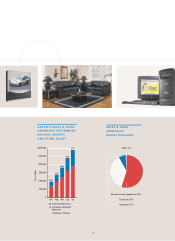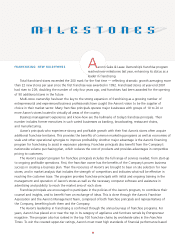Aarons 2001 Annual Report Download - page 19
Download and view the complete annual report
Please find page 19 of the 2001 Aarons annual report below. You can navigate through the pages in the report by either clicking on the pages listed below, or by using the keyword search tool below to find specific information within the annual report.
correct, the Company’s actual liability may be more or less
than the liability recorded at December 31, 2001.
Company Insurance Programs: The Company maintains
insurance contracts for the payment of workers compensation
and group health insurance claims. Using actuarial analysis
and projections, the Company estimates annually the liabilities
associated with open and incurred but not reported workers
compensation claims. This analysis is based upon an assess-
ment of the likely outcome or historical experience, net of
any stop loss or other supplementary coverages. The Company
also calculates on an annual basis, the projected outstanding
plan liability for the group health insurance program.
The Company’s liability for workers compensation insurance
claims and group health insurance was approximately $3.3
million and $3.5 million, respectively at December 31, 2001
and 2000.
If the Company resolves existing workers compensation
claims for amounts which are in excess of the Company’s
current estimates and within policy stop loss limits, the
Company will be required to pay additional amounts beyond
those accrued at December 31, 2001. Additionally, if the actual
group health insurance liability develops in excess of the annual
projection, the Company will be required to pay additional
amounts beyond those accrued at December 31, 2001.
The assumptions and conditions described above reflect
management’s best assumptions and estimates, but these items
involve inherent uncertainties as described above, which may
or may not be controllable by management. As a result, the
accounting for such items could result in different amounts if
management used different assumptions or if different condi-
tions occur in future periods.
For further information concerning accounting policies, refer
to Note A of our Consolidated Financial Statements.
FORWARD LOOKING STATEMENTS
Certain written and oral statements made by our Company
may constitute “forward-looking statements” as defined under
the Private Securities Litigation Reform Act of 1995, including
statements made in this report and other filings with the
Securities and Exchange Commission. All statements which
address operating performance, events or developments that
we expect or anticipate will occur in the future—including
growth in store openings and franchises awarded, market
share, and statements expressing general optimism about
future operating results —are forward-looking statements.
Forward-looking statements are subject to certain risks and
uncertainties that could cause actual results to differ materially.
The Company undertakes no obligation to publicly update
or revise any forward-looking statements. For a discussion
of such risks and uncertainties see “Certain Factors Affecting
Forward-Looking Statements” in the Company’s Annual
Report on Form 10-K for fiscal 2001, filed with the Securities
and Exchange Commission, which discussion is incorporated
herein by this reference.
16
The Company believes that the expected cash flows from
operations, proceeds from the sale of rental return merchan-
dise, bank borrowings and vendor credit will be sufficient to
fund the Company’s capital and liquidity needs for at least
the next 24 months.
As of December 31, 2001 the Board of Directors had
authorized the Company to purchase an additional 1,284,190
shares of Company stock.
The Company has paid dividends for fifteen consecutive
years. A $.02 per share dividend on Common Stock and
on Class A Common Stock was paid in January 2001 and
July 2001, for a total fiscal year cash outlay of $797,000.
The Company currently expects to continue its policy of
paying dividends.
CRITICAL ACCOUNTING POLICIES
Revenue Recognition: Rental revenues are recognized in the
month they are due on the accrual basis of accounting. For
internal management reporting purposes, rental revenues in
the sales and lease ownership division are recognized as rev-
enue in the month the cash is collected. On a monthly basis,
the Company records an accrual for rental revenues due, but
not yet received, and a deferral of revenue for rental payments
received prior to the month due. The Company’s revenue
recognition accounting policy matches the rental revenue
with the corresponding costs (primarily depreciation) associated
with the rental merchandise. At December 31, 2001 and 2000,
the Company had a net revenue deferral representing cash
collected in advance of being due or otherwise earned totaling
approximately $5.7 million and $4.3 million, respectively.
Revenues from the sale of residential and office furniture and
other merchandise are recognized at the time of shipment.
Rental Merchandise Depreciation: The sales and lease own-
ership division depreciates merchandise over the agreement
period, generally 12 to 24 months, when on rent, and 36
months, when not on rent, to a 0% salvage value, with the
exception of merchandise in distribution centers which is not
depreciated during the initial months in the distribution center.
As sales and lease ownership revenues continue to constitute
an increasing percentage of total revenues, the Company
would expect rental merchandise depreciation to increase at
a correspondingly faster rate. The rent-to-rent division depre-
ciates merchandise over its estimated useful life which ranges
from 6 months to 60 months, net of its salvage value which
ranges from 0% to 60%. All rental merchandise is available
for rental and sale. On a monthly basis, the Company writes
off damaged, lost or unsalable merchandise as identified. Such
write-offs totaled approximately $10.0 million, $8.9 million
and $6.7 million during the years ended December 31, 2001,
2000 and 1999, respectively.
Closed Store Reserves: From time to time, the Company
closes or consolidates retail stores. The Company records an
estimate of the future obligation related to closed stores based
upon the present value of the future lease payments and related
commitments, net of estimated sublease income. Sublease
income is based upon historical experience. At December 31,
2001 and 2000, the Company’s reserve for closed stores was
$3.4 million and $350,000, respectively, with the increase
primarily related to rent-to-rent stores closed during 2001. If
the Company’s estimates related to sublease income are not
























